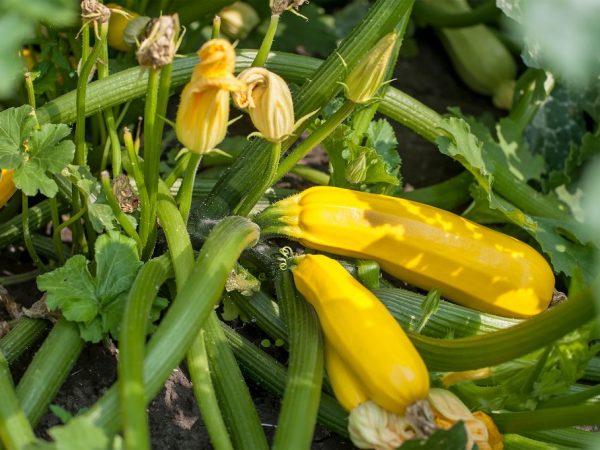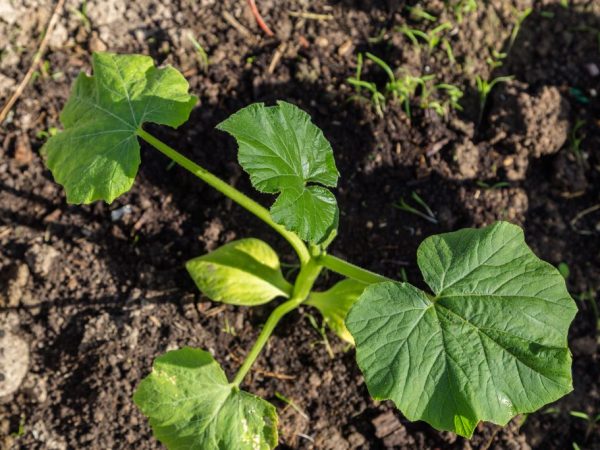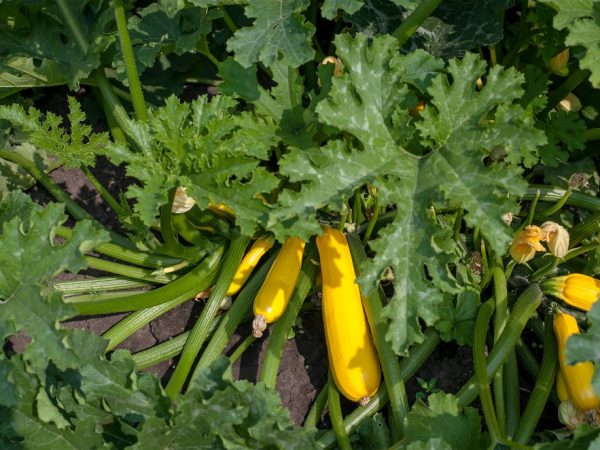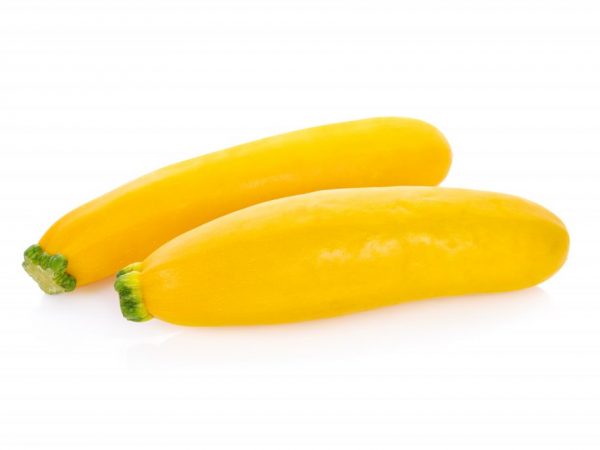Varietal features of zucchini Yasmin F1
The Yasmin F1 squash was bred by Japanese farmers representing the well-known Sakata brand. This variety has a high yield and is rather unpretentious to weather conditions. The vegetable is grown both in greenhouses and on open land plots.

Varietal features of zucchini Yasmin F1
Description
In Russia, this zucchini is very popular not only among producers and farmers of large agricultural firms, but also among the local population.
This species belongs to the zucchini subtype. It is a low shrub with branches collected in one place. His leaves are small for his variety, so they compactly occupy the estimated area. They are also weakly dissected and in some places covered with barely noticeable spots.
In addition, it is resistant to various diseases and infectious agents.
The fruits have the following characteristics:
- cylindrical shape;
- pronounced yellow tint;
- length up to 25 cm:
- ripe zucchini weight - up to 300 g;
- medium-sized seeds in the shape of an ellipse;
- the pulp is dense, creamy.
Benefits
The advantages of this variety include:
- compactness of bushes, which in their own way do not spread their branches over a long distance: 1 sq. m you can plant up to 5 zucchini bushes;
- all fruits grow in sync. This allows you to harvest at the same time, without leaving some vegetables late due to the fact that they did not have time to ripen;
- hybrids grow quickly - in 40 days. This property saves time and effort;
- you can grow zucchini both in greenhouse conditions and in the open field, so farmers have a choice of where it is better to sow or plant a plant;
- fruits contain a large amount of carotene.
The only drawback is the seeds, which, according to their characteristics, are not suitable for further planting and propagation of the plant. It is necessary to sow already treated seeds. You can buy them in specialized stores in packs of 5 pieces.
Growing
The variety can be grown both in the open field and under a film. In the second case, seedlings are used, which are obtained in a bright, warm place (in an apartment it can be a windowsill or a loggia). This method is also suitable when harvesting is planned in the middle of the summer season.

In the north of Russia, it is better to grow zucchini in a greenhouse.
The greenhouse is suitable for areas where the summer is cool and little sun: these are the northern regions of Russia.
Preparatory stage
For the correct cultivation of fruits, it is necessary to take a set of measures before planting seeds:
- in the autumn, it is recommended to loosen well or dig up the soil layer up to 20 cm deep so that the soil is well saturated with oxygen;
- it is necessary to apply mineral fertilizers to increase the nutrient composition of the soil. For 1 sq. m of land, 5 kg of organic matter, superphosphate and potassium impurities in a volume of 30 g are introduced;
- with the arrival of spring, the site prepared for planting must be pierced.This action will help stop the emergence of weeds and harmful crops;
- just before planting the seeds, it is required to loosen the soil again to 10 cm in depth and apply fertilizer. This time, ammonium nitrate is used - about 15 g. If fertilizers were not added in the fall, the soil is replenished with phosphorus and potassium in the amount in which it was necessary to apply them during the autumn events.
Landing
After a complex of preparatory measures, sowing is carried out. As a planting material, you can take either seeds or seedlings grown for 3 weeks in greenhouse conditions.
It is recommended to buy colored seeds because they are pre-treated with special agents that will protect an adult bush from various diseases and pests.
If the seeds have already been processed, they do not need to be soaked before sowing. The soil must be warmed up by the sun's rays to at least 12 ° C, otherwise the grains will not be able to germinate.
It is necessary to prepare a landing site in the form of holes in advance. These holes have their recommended dimensions: 40 cm in diameter and 10 cm deep. Then humus fertilizers or a settled mullein are applied in the amount of 1 kg for each plant.
It is recommended to plant 1 sq. m no more than 3 plants, so that they can receive a sufficient amount of useful elements from the ground, as well as occupy the necessary territory for their optimal growth. They can also be planted next to other zucchini because there is no cross-pollination.
After all the activities, seeds or seedlings are planted and watered with warm, settled water. The process of mulching is also carried out - the introduction of organic fertilizers (for example, composted products).
Thanks to organic matter, the plant throughout its development has a sufficient amount of moisture and is filled with nutrients. For better germination, 100 g of wood ash and a pinch of mineral fertilizers are added to each hole.
Additional instructions
There are rules, the observance of which will help to grow high-quality zucchini:
- if the soil cover of the area prepared for growing a vegetable has strong acidity, it must be reduced by lime or chalk components;
- in the early stages of planting seeds in open ground, a prerequisite is to cover them with a darkened film material. During the day, it is opened a little and the plant is allowed to stay in the fresh air;
- planting of seed takes place from May to June. For this, holes are made in the ground, which are at a distance of 5 cm from each other and have a depth of up to 3 cm;
- 2-3 seeds are placed in each planting recess;
- after the seeds have sprouted, it is necessary to thin them out in such a way that up to two sprouts remain in one hole.
Care

Zucchini should be watered regularly
To get a good harvest at the end of the planting season, it is necessary to perform a set of plant care measures. A description of the steps for growing Yasmin F1 squash can be found on the back of the packaging in which the seeds were sold. These include:
- regular watering. Zucchini needs moisture constantly. After the seeds have been planted, the hole must be watered, since without a certain level of moisture, the plant may not rise and simply dry out in the soil hole. When the flowering period begins at the bush, watering must be increased several times. For example, 1 sq. m use about 2-3 10-liter buckets of water. It is recommended to carry out water procedures in the evening, when the heat subsides and the water warms up to the required temperature;
- fertilization. After the first signs of zucchini germination appear on the surface of the earth, it is necessary to apply fertilizers that affect the growth of fruits. Such procedures are carried out 1-2 times a week, depending on the nutrient composition of the soil.In this case, nitrogen impurities and potassium salt will be the best helpers, because these are the main elements in the development and formation of the fruiting body. If they are not enough, then the top of the vegetable begins to dry out and curl. These impurities are replaced by organic matter, which is used as a mullein;
- loosening. When a crust forms on the surface of the earth and the soil does not receive enough air, it is necessary to loosen it. This effect often occurs after watering plants in the evening.
Disease prevention
Any agricultural crop is exposed to diseases and negative effects of pests. To reduce the impact of these actions, it is periodically recommended to carry out preventive measures to control weeds and pathogens.
The main potential enemies for this type of squash are cucumbers and pumpkin, because there is a great likelihood that their diseases will be transmitted to Yasmin, and a cross-pollination reaction is also possible.
Among the most common vegetable diseases, the following are distinguished: mosaic, rot, powdery mildew and anthracnose. Feeding the root system and the ground part of the crop helps to fight them. Spider mites and aphids can be the causative agents of diseases.
More often, white powdery spots appear on the leaves, which spread over the entire leaf plate and lead to its wilting. A solution of colloidal sulfur helps to get rid of this ailment, which is periodically sprayed (1 time in 20 days) on the plant.
As preventive measures that prevent the appearance of rot, you can use a solution of copper sulfate and water the bush with only warm water.
In the event that the plant could not be saved, it is recommended to burn it, and treat the focus of the disease with copper sulfate. Otherwise, the disease will spread to other bushes.
Harvesting and storage

Fresh vegetables are stored for a month
This zucchini variety produces a good harvest that can be harvested as early as mid-August. Vegetables can be stored in the basement for 4 weeks without degrading their appearance and taste.
It is advisable to remove the fruits from the branches at a time when they reach 25 cm in diameter, so that they do not become harder.
When collecting, they remove unnecessary elements of the shrub: ovaries and small fruits that have not collected enough nutrients to acquire the correct shape and weight. You can leave 2-3 fruits on the bush that correspond to the specified characteristics.
Productivity per 1 sq. m can reach from 4 to 12 kg. It will depend on climatic conditions and crop care.
When the first ovaries appear, some gardeners pour coniferous residues under the bush itself, which will keep moisture and not touch the ground cover. This variety of zucchini can be canned in jars for the winter or used for a regular diet.
Growing errors
The main mistakes that gardeners make in this case are:
- lack of shelter for a plant - in the case when seedlings are grown in April, it is imperative to use film material in order to avoid temperature changes in the environment and possible morning frosts;
- cracks in the fruits - if the ripe zucchini is not collected in time, they begin to crack, therefore it is recommended to pluck them when they grow 20 cm in length;
- the hole of the wrong size - in order for the seeds to sprout, it must have a depth of no more than 5 cm, otherwise they will rot;
- the choice of shady areas for planting - it is worth paying attention to the fact that Yasmin's zucchini loves lighted places and will not be able to mature without sufficient supply of sunlight.
According to reviews left by experienced gardeners, the variety has a high yield and is a win-win option for homemade preparations for the winter.Throughout the entire storage period, the vegetable retains its density and juiciness. Its taste is also distinguished.

